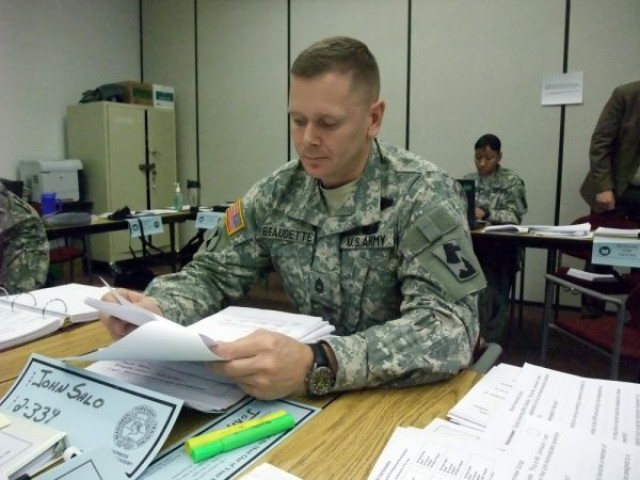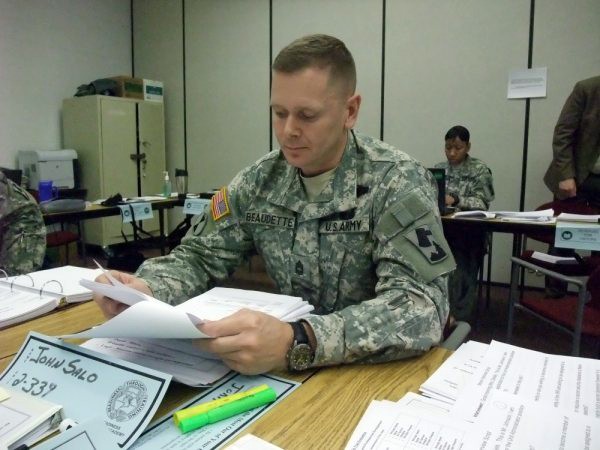FORT MCCOY, Wis. (April 8, 2010) -- Staff and faculty of the Army Reserve Readiness Training Center (Provisional) at Fort McCoy are beginning the process to transition the organization to its new location at Fort Knox, Ky.
Often referred to as the "schoolhouse of the Army Reserve," ARRTC has been located at Fort McCoy since 1976.
The mission of the organization is to develop, sustain and deliver a wide spectrum of functional course-ware and leader-development instruction. The organization also oversees Army Reserve leader-development training, develops Web-based training and distance learning, and coordinates training done by other services and government agencies that support the Army Reserve.
Tim Shuffield, ARRTC director of support, said the current plan is for ARRTC to transition from a provisional organization to an approved structure by October and to relocate to Fort Knox by September 2011.
The relocation was directed as part of the Base Realignment and Closure process in 2005.
"We're in the draft stages of the process right now," Shuffield said. "We're going through the mechanics to determine what the ARRTC will look like in addition to preparing for our move to Fort Knox."
The reconstituted ARRTC will have about 180 personnel and report directly to the U.S. Army Reserve Command.
The NCO Academies at Fort McCoy; Fort Dix, N.J.; and Fort Lewis, Wash., also will be under command and control of the reconstituted ARRTC, he said. Operations and staff for those facilities will remain at their current locations.
The process of the final relocation of the ARRTC involves coordination with the USARC and the 84th Training Command (Leader Readiness). Shuffield said the process also entails acquiring the right personnel.
"Fortunately, we all have been able to sit down to coordinate the new structure and personnel requirements," he said.
"People in the other organizations have realized how important it is that we have the right structure to help prepare for the move," he said. "Our work force also has done an exceptional job in meeting the challenges and demands of the move." Sheffield said he is also coordinating with the 70th Training Division (Functional Training) in preparation for the move.
In addition to all the coordination, other factors, including availability of facilities, will play a role in the projected timeline to move the ARRTC workforce, Shuffield said.
The ARRTC workforce will move to the current Armor School facilities at Fort Knox, he said. For that to happen, the Armor School at Fort Knox needs to move into its new location at Fort Benning, Ga.
Some degree of renovation likely will be required to adapt the Armor School building to meet ARRTC's needs, he said.
As this happens, Shuffield said the ARRTC staff will continue to support its mission of training thousands of personnel each year.
A contracted service that offers Automation Security training at the ARRTC facility is aligned with Fort Gordon, Ga., and is not part of the BRAC move and will remain at Fort McCoy.
Another key factor in the move will be the employees, who are split between Active Guard/Reserve personnel and federal civilians, he said. Each group will bring its own challenges to the moving process.
AGR personnel generally serve three years in an assignment before moving to their next duty station. Shuffield said that the challenge faced with the AGR personnel is they can't be moved if they have been on station less than one year.
Another factor is the timing of their permanent change-of-station move.
"We have to consider all of the effects moving can have," he said, such as spouses leaving jobs sooner than expected or children transferring to another school during an academic year, for example.
Shuffield said many civilian employees have been at Fort McCoy for a number of years and have ties to the local communities, where they live. Their spouses may be employed and they may have children in the school districts or university systems. Many also are nearing the end of their careers and may choose to stay in their current communities rather than move to Fort Knox.
"Typically, the civilian employees have provided the stability and the institutional knowledge while the military have brought in the new ideas and kept the programs current and relevant," he said. "If enough experienced civilians don't transfer to Fort Knox, the roles may be reversed somewhat in the move, with the military personnel initially providing the stability of the workforce."
Shuffield said everyone in the organization has been happy about the time they have spent at Fort McCoy. The classroom and administrative building for ARRTC was completed and occupied at McCoy in 1992 and a new dormitory project was completed in 2000.
"Our move is almost a bittersweet thing," he said. "McCoy has been our home. We've been treated well, and well received. It's exciting to see the ARRTC stand back up, and sad that we have to move."


Social Sharing